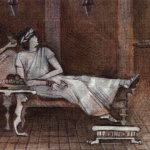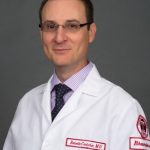There were poignant experiences. “One of the best moments of my residency was encountering a patient who was a very sensitive soul in a very sick body,” Dr. Pierre-Louis describes. “She blossomed when we met with her daily to discuss a poem of her own composition. While we did not make her well, I felt so happy that we shared those delightful moments.” Although he acknowledges that “many might argue that the time it takes to do bedside humanities would be better spent taking care of patients. But what type of care for our patients are we talking about?” Dr. Pierre-Louis and his colleagues learned that, in his words, “medical humanities put everything in perspective. Each patient could be a parent, each child could be yours, and ultimately each doctor is a future patient. The good doctor needs to look at each patient with the eyes of a painter, listen to them with the ears of a musician, and analyze their emotions like a poet.”
One patient, who was introduced to a selection from the humanities curriculum to facilitate care in the ambulatory practice, said it was such a powerful moment that it brought “chills up and down my spine.”
I am enormously proud of my former residents and faculty for not just acknowledging the importance of humanistic care but for making it an essential part of the fabric of the program. We became better doctors for this, and I think our patients received better care. For example, there was the time my faculty chided me for considering the dismissal of a particularly difficult patient; they reminded me of our programmatic imperative to offer humanistic care, to continue our efforts to provide the patient-centered care we espoused, and to aspire to a higher standard. I realized then that my faculty had assimilated what I had hoped to impart about caring for patients, that they had taught me, and that they internalized values with which I still sometimes struggled, despite my idealism; indeed they had surpassed me, and that this meant that I had succeeded in our novel initiative.
Another instance was when one of our residents used his vacation to study Spanish to learn to better communicate with his patients. The candidate pool for residency began to include applicants from places that were never attracted before, presumably reflecting growing awareness of our program.
Graduates told us they were incorporating some of what we did in their practices—one was implementing a medical humanities program at his new institution. The program became affiliated with the Drew University graduate program in medical humanities and bioethics. The Healthcare Foundation of New Jersey recognized the program with their annual leadership award for humanism in healthcare. Colleagues at other medical centers contacted us about adapting the program, or they adopted what we created. We were honored that our program was featured in the November 2008 issue of the Reporter of Association of American Medical Colleges and Pauline Chen’s column in The New York Times (October 23, 2008).23,24 I truly believe these examples reflect that we changed the way our doctors think and do medicine. Humanistic medicine is now imbued in the program, is part of the lexicon, and became an identity. It has continued beyond my departure.
Final Words
What have we learned from this? Bringing humanities to the bedside is not hard. What we did can be generalized. It requires only commitment, will, and passion. It is good for doctors and patients. It may lead to better physician performance and patient care. We do not believe that classroom humanities, without translation to patient care and appropriate role modeling by physicians, imparts to others the full potential value of humanities in teaching and providing humanistic, patient-centered care. We believe that “humanities,” in the bedside setting, should be kept simple and easy for the residents and students. We believe inclusion of humanities in our professional activities, at least to some degree, is essential for us to be the best physicians we can be.


